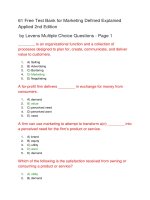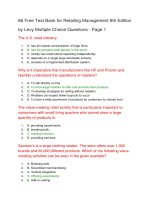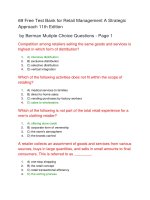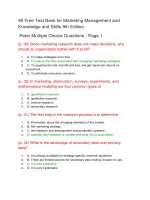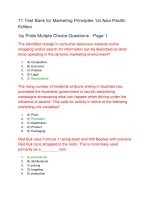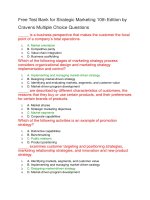58 free test bank for strategic management 5th asia pacific edition
Bạn đang xem bản rút gọn của tài liệu. Xem và tải ngay bản đầy đủ của tài liệu tại đây (97.75 KB, 15 trang )
27 Free Test Bank for Strategic Management 5th Asia
Pacific Edition
by Hanson Multiple Choice Questions
22 Free Test Bank True – False Questions
9 Free Test Bank Free Text Questions
27 Free Test Bank for Strategic Management 5th Asia
Pacific Edition by Hanson Multiple Choice
Questions
A vision statement should be clearly tied to:
1.
2.
3.
4.
A. the stakeholders’ expectations on return on investment
B. the firm’s unique resources and capabilities
C. the conditions of the industry in which the firm operates
D. the conditions in the firm’s external and internal environments
A statement that articulates the ideal description of an
organisation and gives shape to its intended future is
a:
1.
2.
3.
4.
A. strategic mission
B. strategic vision
C. strategic idea
D. strategic objective
Strategic leaders are:
1.
2.
A. the CEO and top-level managers of a firm
B. people who are affected by a firm’s performance and who have claims on its
performance
3. C. the individuals and groups who have invested capital in a firm in the
expectation of earning positive return on their investment
4. D. people located in different parts of the firm using the strategic management
process to help the firm reach its vision and mission
A strategic mission:
1.
2.
3.
A. is based on the application of strategic vision
B. is a firm’s attempt to establish new businesses
C. does not limit the firm by specifying the industry in which the firm intends to
compete
4. D. is developed before a firm develops its strategic intent
To be strategically flexible on a continuing basis and to gain
the competitive benefits of such flexibility, a firm has
to develop the capacity to:
1.
2.
3.
4.
A. understand customer needs
B. learn
C. work closely with suppliers
D. observe competitors carefully
The work of effective strategic leaders is characterised by:
1.
2.
3.
4.
A. ambiguous decision situations
B. high income levels
C. a high level of certainty in the organisation
D. a lack of ability to affect the firm’s direction
A business-level strategy describes:
1.
2.
3.
4.
A. the businesses in which a company intends to compete
B. all policies and procedures used in functional departments
C. a firm’s actions to exploit its competitive advantage over rivals
D. a firm’s resources, intent and mission
Which of the following is not a step in identifying profit
pools?
1.
2.
3.
4.
5.
A. Define the pool’s boundaries.
B. Estimate the pool’s overall size.
C. Estimate the pool’s effect on current activities.
D. Estimate the size of the value-chain activity in the pool.
E. Reconcile the calculations.
Which of the following is not a characteristic of
hypercompetition?
1.
2.
3.
4.
A. competition to generate more customers from underdeveloped markets
B. competition to protect or invade established product or geographic markets
C. competition to create new know-how and establish first-mover advantage
D. price-quality positioning
Returns are often measured by:
1.
2.
3.
4.
A. the level of innovation within the organisation
B. the firm’s stock price
C. the number of industries in which the firm participates
D. the number of customers the organisation serves
Organisational stakeholders are usually satisfied when:
1.
A. their return on investment has been maximised
2.
B. customers pay the highest sustainable price for the goods and services they
receive
3. C. companies are willing to be longer-term employers
4. D. companies are growing and helping individuals develop their skills
The strategic management process is:
1.
2.
A. a set of activities that is guaranteed to prevent organisational failure
B. a process concerned with a firm’s resources, capabilities and competencies, but
not with conditions in its external environment
3. C. a set of activities that have not been used successfully in the not-for-profit
sector
4. D. a dynamic process involving the full set of commitments, decisions and actions
related to a firm
A firm has a competitive advantage when:
1.
2.
3.
4.
A. the value-creating strategy is in the formulation stage
B. competitors are simultaneously implementing the strategy
C. competitors are not able to duplicate the strategy
D. average returns are earned by the company
The resource-based view of the firm:
1.
A. suggests that resources, rather than capabilities, are more closely linked with
sustainable competitive advantage
2. B. argues that the industry environment has a stronger influence on a firm’s ability
to implement strategies successfully than the competitor environment
3. C. calls for firms to focus on their homogeneous skills to compete against their
rivals
4. D. assumes that resources may not be mobile across firms
Capital market stakeholders include:
1.
2.
3.
4.
A. unions
B. employees
C. shareholders
D. government regulators
The I/O model argues that:
1.
A. internal resources and capabilities represent the foundation for the
development of a value-creating strategy
2. B. firms should seek to maximise their returns by structuring their organisation in a
manner consistent with the most efficient producers in any given industry
3. C. the conditions and characteristics of the external environment are the primary
inputs to and determinants of strategy
4. D. internationalisation in certain industries will lead to globalisation
Organisational culture is:
1.
2.
A. an appreciation for the arts in the organisation
B. an organisation’s ability to act in a responsible manner towards all of its
employees
3.
4.
C. the amount of a firm’s social activity in the community
D. the complex set of ideologies, symbols and core values shared by most
members of the organisation
Generally speaking, product market stakeholders are
satisfied when:
1.
A. a firm’s profit margin yields the lowest return to capital market stakeholders that
is acceptable to them
2. B. a firm’s profit margin yields an above-average return to its capital market
stakeholders
3. C. the interests of a firm’s organisational stakeholders have been maximised
4. D. a firm grounds its operations in the principles of the resource-based view of the
firm rather than the principles of the I/O model
Which of the following is not a risk of globalisation?
1.
2.
3.
4.
A. the amount of time required to learn how to compete in unfamiliar markets
B. increased diversity in the workforce
C. over-diversification internationally beyond capabilities to manage operations
D. new rules of law and governance
Which of the following are the three key categories of firm
resources?
1.
2.
3.
4.
A. Physical, knowledge and organisational
B. Physical, human and organisational
C. Physical, technological and human
D. Physical, technological and reputational
Strategic management and choices made when designing
and using the strategic management process are
driven by the:
1.
2.
3.
4.
A. need to attain returns
B. pursuit of competitiveness
C. actions of employees
D. firm’s strategic standards
Product market stakeholders include a firm’s customers. The
principal concern of this stakeholder group is:
1.
2.
3.
4.
A. maximising the firm’s return on investment
B. providing a stimulating career environment for employees
C. obtaining reliable products at the lowest possible price
D. increasing the profitability of the firm
The resource-based model of the firm contends that:
1.
A. resources that are valuable, rare, costly to imitate and non-substitutable form
the basis of a firm’s competitive advantage
2.
B. the key to competitive success is the structure of the industry in which a firm
competes
3. C. resources have the potential to be the basis of sustained competitive
advantage
4. D. competencies are not a source of potential competitive advantage
Determining the boundaries of an industry has become
challenging in the twenty-first-century competitive
landscape because:
1.
2.
3.
A. firms can have multi-use resources at their disposal
B. firms have become single-entity enterprises
C. managers have adopted a new mind-set to capture the realities of the
landscape
4. D. firms transfer their core competencies across geographic borders
What has a firm achieved when it successfully formulates
and implements a value-creating strategy?
1.
2.
3.
4.
A. Strategic competitiveness
B. A permanently sustainable competitive advantage
C. Substantial returns
D. Average returns
In a diversified firm, corporate-level strategy is concerned
with:
1.
2.
3.
A. operating each individual business
B. determining how each functional department of the firm will operate
C. determining in which businesses to compete and how resources will be
allocated between businesses
4. D. maximising product distribution over rivals
Research findings support the I/O model, in that
approximately ________ of a firm’s profitability can be
explained by the industry in which it chooses to
compete. However, this research also shows that
________ of the variance in profitability could be
attributed to the firm’s characteristics and actions.
1.
2.
3.
4.
A. 24 per cent; 40 per cent
B. 22 per cent; 42 per cent
C. 20 per cent; 36 per cent
D. 26 per cent; 38 per cent
22 Free Test Bank for Strategic Management 5th Asia
Pacific Edition by Hanson True - False Questions
Strategic flexibility is a set of capabilities used to respond to
various demands and opportunities existing in a
dynamic and uncertain competitive environment.
1.
2.
True
False
The resource-based model assumes that differences in
resources and capabilities are the basis of a
competitive advantage.
1.
2.
True
False
A firm’s mission tends to be enduring while its vision can
change in view of changing environmental conditions.
1.
2.
True
False
A profit pool includes the total profits earned in an industry
at all points along the value chain.
1.
2.
True
False
A firm has a competitive advantage when it implements a
strategy that competitors are able to duplicate or find
costly to imitate.
1.
2.
True
False
Employees, managers and non-managers are examples of
organisational stakeholders.
1.
2.
True
False
Strategic competitiveness is achieved when a firm
successfully formulates and implements a valuecreating strategy.
1.
2.
True
False
Organisational stakeholders are a firm’s internal resources,
capabilities and core competencies that are used to
accomplish what may at first appear to be unattainable
goals in the competitive environment.
1.
2.
True
False
Corporate-level strategy is concerned with how a diversified
firm competes in each industry in which it is active.
1.
2.
True
False
Organisational culture refers to the core values shared by a
firm’s managers but not necessarily by its lower-level
employees.
1.
2.
True
False
The industrial organisation (I/O) model suggests that aboveaverage returns are earned when firms implement a
strategy dictated by the characteristics of the general,
industry and competitor environments.
1.
2.
True
False
A strategy is a coordinated set of actions designed to exploit
core competencies and gain a competitive advantage.
1.
2.
True
False
Perpetual innovation is a term used to describe how rapidly
and consistently new, information-intensive
technologies replace older ones.
1.
2.
True
False
Customers, suppliers, unions and local governments are
examples of capital market stakeholders.
1.
2.
True
False
When products become somewhat indistinguishable
because of the widespread and rapid diffusion of
technologies, speed to market may be the primary
source of competitive advantage.
1.
2.
True
False
A core competency is the capacity for a set of resources to
perform a task or an activity in an integrative manner.
1.
2.
True
False
The risks of participating outside of a firm’s domestic
country in the global economy are labelled a ‘liability
of newness’.
1.
2.
True
False
Firms that are capable of successfully competing in global
markets may not need to worry about their home
markets.
1.
2.
True
False
A business-level strategy describes a firm’s actions
designed to exploit its resources and capabilities.
1.
2.
True
False
Above-average returns are returns in excess of what an
investor expects to earn from other investments with a
similar amount of risk.
1.
2.
True
False
Knowledge is a critical organisational resource and an
increasingly valuable source of competitive
advantage.
1.
2.
True
False
The I/O model argues that core competencies are the basis
of a firm’s competitive advantage.
1.
2.
True
False
9 Free Test Bank for Strategic Management 5th Asia
Pacific Edition by Hanson Free Text Questions
What are some of the effects that technology and
technological changes have on the competitive
landscape?
Answer Given
There are three categories of trends and conditions – technology diffusion and
disruptive technologies, the information age and increasing knowledge intensity –
through which technology is significantly altering the nature of competition and
contributing to unstable competitive environments. Perpetual innovation and the
time to gather information are indicators of technology diffusion. In some
industries, intellectual properties such as patents cannot provide the necessary
protection because of the perils of disclosing information during the patent
application process. Disruptive technologies such as the internet, the declining
costs of information technologies and the increased accessibility to them have
contributed to hypercompetition. Finally, knowledge is a critical resource that forms
the basis of technology and its application. Knowledge flows within an organisation
are essential to the execution of technologies. Doing this well will generate even
greater efficiency and more competition in the market.
Describe the steps of the strategic management process.
Answer Given
A firm’s first step in the process is to analyse its external and internal
environments to determine its resources, capabilities and core competencies – the
sources of its ‘strategic inputs’. With this information, the firm develops its vision
and mission and formulates its strategy. To implement this strategy, the firm takes
actions toward achieving strategic competitiveness and above-average returns.
These activities involve effective strategic actions that occur in the context of
carefully integrated strategy formulation and implementation actions that result in
desired strategic outcomes. It is a dynamic process, as ever-changing markets
and competitive structures must be coordinated with a firm’s continuously evolving
strategic inputs.
Describe and discuss the resource-based model of aboveaverage returns.
Answer Given
The resource-based model focuses on the internal resources and capabilities of a
firm as a source of competitive advantage. The model assumes that each firm is a
collection of unique resources and capabilities. Resources are not highly mobile
across firms. All firms within a particular industry may not possess the same
strategically relevant resources and capabilities.
Describe an organisation’s various stakeholders and their
different interests.
Answer Given
Stakeholders are the individuals and groups who can affect and are affected by
the strategic outcomes achieved and who have enforceable claims on a firm’s
performance. There are three principal types of stakeholders. First, there are the
capital market stakeholders, which include the shareholders and the major
suppliers of capital to the firm. They are most interested in the return on capital
and the firm’s profitability. The second group of stakeholders are the product
market stakeholders, which include customers, suppliers, host communities and
unions representing workers. The customers seek a reliable product at the lowest
possible price. The suppliers seek assured customers willing to pay the highest
sustainable price. Host communities want companies willing to be long-term
employers and providers of tax revenues. Union officials want secure jobs with
good working conditions for the workers they represent. The final group of
stakeholders are the organisational stakeholders. This group includes the
employees (both managerial and non-managerial). These stakeholders expect a
firm to provide a dynamic, stimulating and rewarding work environment.
Describe the industrial organisation (I/O) model of strategy.
Answer Given
The I/O model is grounded in economics and argues that the external environment
is the primary determinant of a firm’s success. The model has four underlying
assumptions. First, the external environment is assumed to impose pressures and
constraints that determine the strategies that will result in superior performance.
Second, most firms competing within a particular industry, or in a certain segment
of the industry, are assumed to control similar strategically relevant resources and
to pursue similar strategies in light of those resources. Third, resources used to
implement strategies are mobile across firms, which results in resource
differences between firms being short lived. Fourth, organisational decision
makers are assumed to be rational and committed to acting in the firm’s best
interests, as shown by their profit-maximising behaviours. The challenge for firms
within the I/O model is to find the best industries in which to compete.
What is globalisation? What are the benefits and risks for an
organisation operating in a global marketplace?
Answer Given
Globalisation is the increasing economic interdependence among countries and
their organisations as reflected in the flow of financial capital, knowledge and
goods and services across borders. The benefits of globalisation include
increased access to capital resources and higher performance standards in
quality, productivity, cost, product introduction time and operational efficiency. In
general, global organisations have greater access to both skilled and unskilled
workers, and can access multiple markets to obtain the resources necessary to
remain competitive. Organisations engaging in global operations must ensure they
are culturally sensitive to the values and norms of the host country, and must
overcome the ‘liability of foreignness’. Additional risks of operating globally include
the time delay associated with learning how to compete in markets that are new to
them and the possibility of over-diversification, which may result in ineffective
management of the business’s global operations.
Describe and discuss strategic vision and strategic mission.
Answer Given
Strategic vision is a picture of what the firm wants to be and, in broad terms, what
it wants to ultimately achieve. A vision statement articulates the ideal description of
the organisation and gives shape to its intended future. It points the firm in the
direction of where it would eventually like to be in the years to come. A vision
stretches and challenges people and evokes emotions and dreams. The vision is
the foundation for the firm’s mission.
Who are strategic leaders and what determines the
effectiveness of their work?
Answer Given
Strategic leaders are people located in different parts of a firm who use the
strategic management process to help the firm reach its vision and mission.
Successful strategic leaders are decisive and committed to nurturing people
around them. CEOs and other top-level managers are not the only strategic
leaders; there are many people in today’s organisations who help choose a firm’s
strategy and then determine the actions to be taken to successfully implement it.
Hard work, thorough analysis, a willingness to be brutally honest, a desire for the
firm and its people to accomplish more, and common sense are prerequisites of a
successful strategic leader. Effective strategic leaders set an ethical tone in their
firms.
How does knowledge contribute to the competitive standing
of an organisation? Is knowledge a tangible or
intangible resource of the organisation?
Answer Given
Knowledge (information, intelligence and expertise) is the basis of technology and
its application. In the competitive landscape of the twenty-first century, knowledge
is a critical organisational resource and an increasingly valuable source of
competitive advantage. Organisational knowledge is gained through experience,
observation and inference; it is an intangible resource. The value of intangible
resources, such as knowledge, is increasing as a proportion of total shareholder
value in today’s competitive environment. The probability of achieving strategic
competitiveness is enhanced for firms that develop the ability to capture
intelligence, transform it into useable knowledge, and diffuse it rapidly throughout
the company. Organisations must develop and acquire knowledge, integrate it into
the organisation to create capabilities and then apply it to gain a competitive
advantage. Continuous learning provides the firm with new and up-to-date skill
sets, which allow it to adapt to its environment as it encounters changes. Firms
capable of rapidly and broadly applying what they have learnt exhibit the strategic
flexibility and capacity to change in ways that will increase the probability of
successfully dealing with uncertain, hypercompetitive environments.

